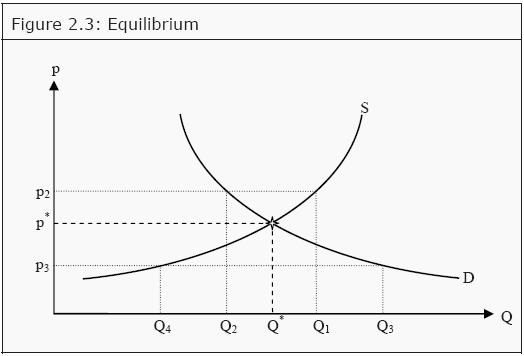Market Equilibrium
Market Equilibrium Assignment Help | Market Equilibrium Homework Help
Equilibrium
A market is in equilibrium when both of these conditions are fulfilled:
1. No agent wants to change her decision or strategy.
2. The decisions of all agents are compatible with each other, so that they can all be carried out simultaneously.
If we join the supply and demand curves in one diagram, we get an equilibrium point where the two curves intersect. At this point, the price the consumers are willing to pay is the same as the price the producers demand. In Figure 2.3, the equilibrium price (market-clearing price) is p* and the equilibrium quantity is Q*.

The equilibrium point has two important properties in that it is most often (but not always) stable and self-correcting. That it is stable means that, if the market is in equilibrium there is no tendency to move away from it. That it is self-correcting means that, if the market is not in equilibrium then there is a tendency to move towards it.
To see more clearly what this means, suppose the price is higher than in equilibrium, e.g. that it is p2. At that price, producers are willing to supply the quantity Q1 whereas the consumers are only willing to buy the quantity Q2. Therefore, there is an excess supply of the good. To get rid of the extra units the producers are prepared to lower the price. This will push the price downwards, closer to p*. At p*, there is no excess supply and the downward push on the price ends.
Then assume, instead, that the price is lower than p*, e.g. that it is p3. At this price, the consumers demand the quantity Q3 whereas the producers are only willing to supply the quantity Q4. Consequently, there will be a shortage of the good, and the consumers will be prepared to bid up the price to get more units. This will tend to push the price upwards, closer to p* where, again, the push will end.